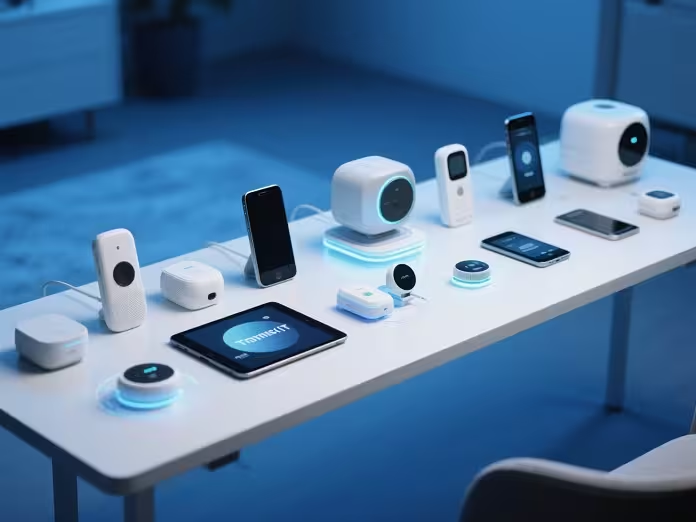
The quiet revolution happening in homes around the world isn’t making headlines, but it’s fundamentally changing how we live, work, and interact with our surroundings. IoT smart devices in daily life have evolved from futuristic concepts to essential companions that anticipate our needs, streamline our routines, and create unprecedented levels of convenience and control.
The Morning That Knows You’re Awake
Picture this: your alarm clock doesn’t just wake you up—it communicates with your coffee maker to start brewing your morning cup, adjusts your thermostat to the perfect temperature, and gradually brightens your smart lights to ease you into consciousness. This isn’t science fiction; it’s the reality of IoT smart devices in daily life transforming ordinary mornings into orchestrated experiences.
Smart home ecosystems have become the conductors of our daily symphonies. Voice assistants like Amazon Alexa, Google Assistant, and Apple’s Siri serve as the central nervous system, coordinating between dozens of connected devices to create seamless experiences that adapt to our preferences and schedules.
Beyond Convenience: The Intelligence Revolution
The true power of IoT smart devices lies not just in remote control capabilities, but in their ability to learn, predict, and act independently. Smart thermostats like Nest and Ecobee don’t just maintain temperature—they study your habits, detect when you’re away, and optimize energy consumption while ensuring comfort upon your return.
Smart refrigerators have evolved into kitchen command centers, tracking inventory, suggesting recipes based on available ingredients, and even ordering groceries when supplies run low. These devices represent a fundamental shift from reactive to proactive technology, where our appliances become partners in managing our lives.
Health and Wellness: Your Personal Care Network
IoT smart devices in daily life have revolutionized personal health monitoring. Wearable devices like smartwatches and fitness trackers continuously monitor vital signs, sleep patterns, and activity levels, providing real-time insights that were once only available in medical facilities.
Smart scales that measure body composition, blood pressure monitors that sync with smartphone apps, and even smart pill dispensers that ensure medication adherence have created a comprehensive health ecosystem. These devices don’t just collect data—they provide actionable insights and early warning systems that can prevent health issues before they become serious.
The integration extends beyond individual monitoring. Smart air quality sensors detect pollutants and allergens, automatically adjusting air purifiers and HVAC systems to maintain optimal indoor environments. Sleep tracking devices communicate with smart mattresses to adjust firmness and temperature throughout the night, optimizing rest quality.
Security That Never Sleeps
Home security has been transformed by IoT technology, creating surveillance and protection systems that operate 24/7 with minimal human intervention. Smart doorbells with video capabilities, motion sensors that distinguish between pets and intruders, and locks that can be controlled remotely have created multi-layered security ecosystems.
These systems leverage artificial intelligence to reduce false alarms while ensuring genuine threats are immediately detected and reported. Smart cameras can recognize familiar faces, send targeted alerts, and even coordinate with local emergency services when necessary.
The Connected Kitchen: Culinary Intelligence
Cooking has become an interactive, intelligent experience through IoT integration. Smart ovens that can be preheated remotely, cooking thermometers that send alerts when food reaches perfect temperatures, and recipe apps that adjust cooking times based on real-time conditions have transformed meal preparation.
Smart dishwashers optimize water usage and cycle selection based on load detection, while connected coffee makers ensure your morning brew is perfectly timed with your wake-up routine. These devices don’t just perform tasks—they enhance the entire culinary experience through precision and personalization.
Energy Efficiency: The Environmental Impact
IoT smart devices are driving significant improvements in energy consumption and environmental sustainability. Smart lighting systems that adjust brightness based on natural light availability and occupancy sensors reduce electricity waste. Intelligent irrigation systems monitor soil moisture and weather forecasts to optimize water usage for gardens and lawns.
Energy monitoring devices provide detailed consumption analytics, enabling homeowners to identify and eliminate inefficiencies. Some systems can even automatically shift energy usage to off-peak hours, reducing costs and grid strain.
Challenges in the Connected World
Despite the remarkable benefits, IoT smart devices in daily life present unique challenges. Privacy concerns arise as devices collect vast amounts of personal data. Security vulnerabilities can potentially expose homes to cyber threats. The complexity of managing multiple connected devices can sometimes create more problems than solutions.
Interoperability remains a significant hurdle, as devices from different manufacturers may not communicate effectively. The rapid pace of technological advancement also means devices can become obsolete quickly, creating electronic waste and forcing frequent upgrades.
The Future Landscape
The trajectory of IoT development points toward even more sophisticated integration and intelligence. Artificial intelligence and machine learning capabilities are becoming more powerful, enabling devices to make increasingly complex decisions and predictions.
Edge computing is bringing processing power closer to devices, reducing latency and improving response times. 5G networks are enabling faster, more reliable connections that support more sophisticated IoT applications.
Augmented reality interfaces are beginning to emerge, allowing users to interact with their IoT ecosystems through visual overlays and gesture controls. Voice recognition is becoming more natural and conversational, making human-device interaction more intuitive.
Embracing the Connected Future
IoT smart devices in daily life represent more than technological advancement—they embody a fundamental shift toward intelligent, responsive living environments. As these systems become more sophisticated and affordable, they’re democratizing access to convenience, efficiency, and control that was once available only to the technologically elite.
The key to maximizing benefits while minimizing risks lies in thoughtful implementation, regular security updates, and maintaining awareness of privacy implications. As we continue to invite these intelligent devices into our homes and lives, we’re not just adopting new technology—we’re participating in the creation of smarter, more responsive living spaces that adapt to our needs and preferences.
The transformation is already underway. The question isn’t whether IoT smart devices will continue to reshape daily life, but how quickly and completely we’ll embrace the possibilities they offer. The future of living isn’t just connected—it’s intelligent, responsive, and more human than ever before.































